

The Upanishads ~ pure vedic Spirituality ~(translation as it is/audiobook) What Is Puja: Traditional Step of the Vedic Ritual. Puja is worship.

The Sanskrit term puja is used in Hinduism to refer to the worship of a deity through observance of rituals including daily prayer offerings after a bath or as varied as the following: Sandhyopasana: The meditation on God as the light of knowledge and wisdom at dawn and duskAarti: Ritual of worship in which light or lamps are offered to the deities amid devotional songs and prayer chants. Homa: The offering of oblations to the deity in a duly consecrated fireJagarana: Keeping vigil at night amidst much devotional singing as a part of spiritual discipline.Upavasa: Ceremonial fasting. All these rituals for puja are a means to achieve purity of mind and focusing on the divine, which Hindus believe, can be a fitting stepping stone to knowing the Supreme Being or Brahman.
Why You Need an Image or Idol for a Puja. The Notion of Growth. Sama Veda - download the PDF English Translation here. Samsara (Hinduism) Hinduism Basics. Hinduism is the major religion of India, and the vast majority of India's population today is Hindu; however, Hinduism has spread all over the world and is truly a "world" religion.
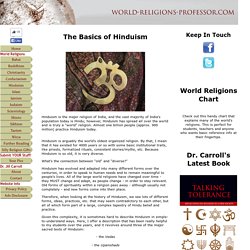
Almost one billion people (approx. 900 million) practice Hinduism today. Hinduism is arguably the world's oldest organized religion. By that, I mean that it has existed for 4000 years or so with some basic institutional traits, like priests, formalized rituals, consistent stories/myths, etc. Because Hinduism is so old, it is very diverse.
What's the connection between "old" and "diverse? " Hinduism has evolved and adapted into many different forms over the centuries, in order to speak to human needs and to remain meaningful to people's lives. Hinduism. Sacred-texts home Journal Articles: Hinduism OCRT: Hinduism Buy CD-ROM Buy books about Hinduism Vedas Upanishads Puranas Other Primary Texts Epics Mahabharata Ramayana Bhagavad Gita Vedanta Later texts Modern books The Vedas.
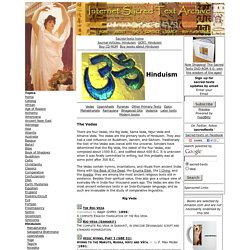
Hindu Theory of World Cycles. Traditional Hindu scriptures view history as cyclical in character, with vast repeating series of ages.
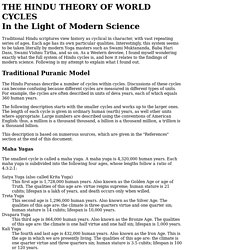
Each age has its own particular qualities. Interestingly, this system seems to be taken literally by modern Yoga masters such as Swami Muktananda, Baba Hari Dass, Swami Vishnu Tirtha, and so on. As a Western devotee, I found myself wondering exactly what the full system of Hindu cycles is, and how it relates to the findings of modern science. Following is my attempt to explain what I found out. Traditional Puranic Model. Gita. Manas: Religious texts of India, Puranas. Puranas The Puranas are a class of literary texts, all written in Sanskrit verse, whose composition dates from the 4th century BCE to about 1,000 A.D.
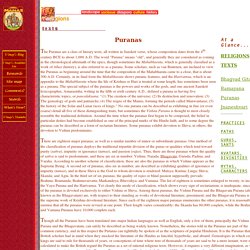
Great Systems of Yoga: Chapter Two. Patanjali's Raja Yoga. Sacred Texts Hinduism Yoga Index Previous Next Buy this Book at Amazon.com Great Systems of Yoga, by Ernest Wood, [1954], at sacred-texts.com p. 12 p. 13 p. 14 p. 15 FOREMOST among the Yoga teachings of India comes that of Patanjali dating back, according to popular tradition, to at least 300 B.C.

P. 16 is its positive characteristic. Vritti means literally a whirlpool, and nirodha signifies restraint or control. The Science of Pranayama. Holy science. Hindu Dharma: The Garland Of Letters : John Woodroffe : Free Download, Borrow, and Streaming. Maharshi Veda Vyasa: The Life and Works of Hindu Sages. By Subhamoy Das Updated May 12, 2016.
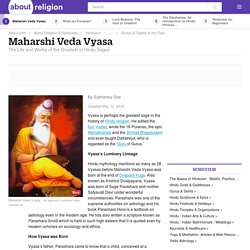
Vyasa is perhaps the greatest sage in the history of Hindu religion. He edited the four Vedas, wrote the 18 Puranas, the epic Mahabharata and the Srimad Bhagavatam and even taught Dattatreya, who is regarded as the ‘Guru of Gurus.’ Vyasa’s Luminary Lineage Hindu mythology mentions as many as 28 Vyasas before Maharshi Veda Vyasa was born at the end of Dvapara Yuga. How Vyasa was Born Vyasa’s father, Parashara came to know that a child, conceived at a particular moment of time, would be born as the greatest man of the age as a part of Lord Vishnu himself.
On that eventful day, Parashara was travelling in a boat and he spoke to the boatman about the nearing of that auspicious time. Swami Sarvapriyanandaji-"MESSAGE OF THE UPANISHADS" at IIT Kanpur. Hindu Culture - Omkar and Swastika. [an error occurred while processing this directive] Hindu Symbols and Symbolisms - Omkar, Swastika, the Saffron Colour and Purna-kumbha by Sudheer Birodkar.
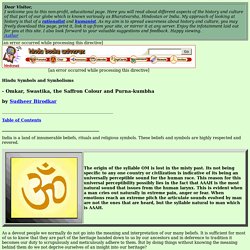
Effects of Pranayama on the Brain. Pranayama, or expansion of the prana or vital energy, occurs through the practices of prana nigraha, or control of the prana (1).
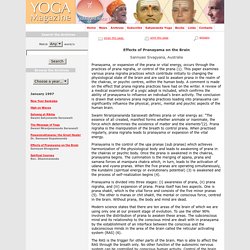
This paper examines various prana nigraha practices which contribute initially to changing the physiological state of the brain and are said to awaken prana in the realm of the chakras, or psychic centres, within the human body. A comment is made on the effect that prana nigraha practices have had on the writer. A review of a medical examination of a yogic adept is included, which confirms the ability of pranayama to influence an indivdual's brain activity. Sacred Geometry, Energised Vedic Yantras, Shri Yanthra.
Related Reading .... 1.

List of Yantras (with photos) - Part I 2. List of Yantras (with photos) - Part II 3. Crystal Yantras 4. Group Yantras 5. Am I A Hindu. In Depth Study of KARMA & REINCARNATION Concepts WHAT IS KARMA? The word KARMA has many meanings in Hinduism such as 1. Action 2. Duty 3. Stories from Hindu epics / purANas. Kings with Straw Mats - Yogis and Sadhus of the Kumbh Mela Festival. Vikas Dhavaria. Translation of Shrauta in English. Shrauta - Expand Your Mind. Hindu Scriptures, The Puranas, Vedangas, Devotional Literature. By Jayaram V. Manas: Religious texts of India, Puranas.
18 Major Puranas. Puranas of Hinduism. Mahabharata (Hindu epic) Hinduism Hindu Religion: Discussion Metaphysics Philosophy of Hinduism Beliefs, Hindu Gods. Discussion of Metaphysics & Philosophy of Hinduism Beliefs & Hindu Gods All is One / Brahman (Reality, Space) is One and Dynamic Quotes / Quotations, Pictures, Information on Hinduism Though One, Brahman is the cause of the many. Brahman is the unborn (aja) in whom all existing things abide. The One manifests as the many, the formless putting on forms.
(Rig Veda) Behold but One in all things; it is the second that leads you astray. (Kabir) The word Brahman means growth and is suggestive of life, motion, progress. Hindu cosmology is non-dualistic. HINDUISM: The world's third largest religion. Religions of the world Menu Sponsored link. Overview: Hinduism differs from Christianity and other monotheistic religions in that it does not have: Hindu cosmology. In Hindu cosmology the universe is cyclically created and destroyed. What Are the Upanishads? - Indian Philosophy. Upanishads. The Upanishads are a collection of texts of religious and philosophical nature, written in India probably between c. 800 BCE and c. 500 BCE, during a time when Indian society started to question the traditional Vedic religious order.
Some people during this time decided to engage in the pursuit of spiritual progress, living as ascetic hermits, rejecting ordinary material concerns and giving up family life. The Vedas. The Vedas are a collection of hymns and other religious texts composed in India between about 1500 and 1000 BCE. Mahabharata: complete synopsis and notes. The BHAGAVAD-GITA in English. The Ramayana index. Manas: Religious texts of India, Ramayana. Ramayana. Valmiki Ramayana. The Mahābhārata.